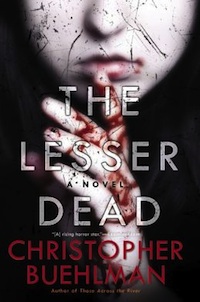Joey Peacock looks fourteen… at least, most of the time he does. He’s actually pushing fifty. He was turned by a vampire who used to be his housekeeper, a fearsome Irishwoman named Margaret. The two of them carve out a comfortable existence in 1970s Manhattan, where Margaret is the undisputed alpha of a tight, clean-living vampire crew who inhabit the New York subways, mesmerizing people on the rare occasions when they run into trouble, leaving most of their victims alive.
Sustainable hunting practices aside, these vampires are settled into a comfortable routine with each other. They share a laundry; they’re practically family. Each maintains a set of regular human victims, whom they visit and drink.
Then one day Joey sees a bunch of little undead kids on the subway, using their charm to lure a hapless dad type into the tunnels. Somehow these new arrivals don’t look like they’re playing catch-and-release.
The children, Joey reasons, must have been made into monsters when they were too young to figure out how to go about avoiding police attention. They are in serious need of teaching. But, in the meantime, they are not only playing with their food but killing it afterward. The immediate problem is that Margaret has strict rules. One of these is zero tolerance for vampires who endanger her pack, even if they do look like tiny little kids.
Christopher Buehlman opens The Lesser Dead with a long, chatty, anecdote-laden narrative by Joey which introduces him, Margaret, and all of their minions, rivals and allies. Chief among these is Cvetko, an old Hungarian intellectual and big time fuddy-duddy who has taken it upon himself to play father figure to Joey. Cvetko is so adorable and bookish you kind of want to invite him into your home and open up a vein for him before settling in for a long game of chess.
The story winds to and fro like a river on the plains, rounding past Joey’s short past as a living human being, drifting through the events which brought him into conflict with Margaret, sharing the tale of his death and rebirth. We get nifty little glimpses of life in the underworld, a sense of the pack’s power dynamics, and as a bonus we get to relive the age of disco. In the process, it’s all too easy to become fond of the pack, even more so when the vampires track down the feral children and begin the difficult process of teaching them table manners. The only thing better would be if Joey brought home a box of puppies.
Joey and Cvetko get Margaret on board with not exterminating the kids immediately, though it takes some doing. After that, the top priority as far as any of the group can see is identifying the vampire who created this deadly pack of lost moppets… and making them pay. Whether that vampire is someone they can or should take on is secondary to—oddly enough—their moral outrage.
Audiences love a charismatic predator: it’s why we watch documentaries on lions and wolf packs and films about Al Capone. They’re not nice, but they have a certain charm. We root for them, at least a little, and when things start to go wrong for Margaret’s crew, it’s stunning how much we care.
And things do, inevitably, go wrong. Human deaths are almost incidental in The Lesser Dead. People do die—quite a few of them, as it happens—but they’re collateral damage in something that cascades into all-out vampire war.
One could get lofty, I suppose, and sketch out the conflict as a difference in perspective, a power struggle between practitioners ofunrestricted hunting and Margaret’s managed harvest approach. But the carnage that results as the vampire family goes looking for the kids’ maker defies polite terminology. This book is what we invented the word bloodbath for: it’s surprising, scary, and, ultimately, heartbreaking. It dangles false hope in front of readers only to snatch them away. It tells a story where any idea of cuddly vampires becomes a sick, dark, and not terribly funny joke.
Buehlman also plays with a standard image from the horror canon: the creepy ghost or monster-child. Tragically dead, eerily innocent, and equipped with sharp teeth, these figures appear in films and movies beyond count, barefoot, dressed in tattered nightgowns, often clutching a ratty, dead-eyed doll. They’re often a symptom of something bigger at work; they’re sidekicks, usually, of a more powerful force of evil. In The Lesser Dead, this trope gets deconstructed and rebuilt in strange and delightful ways. Even watching a pack of murderous bloodsucking fiends as they take on nurturance is a mind-bender.
I’ve read a number of good horror novels this year, but Buehlman leaves them all in the dust. His last two books were terrific, and this one is sheerly amazing. If your idea of fun includes being seriously discomfited, grab up The Lesser Dead as soon as you can.
A.M. Dellamonica has written many things for Tor.com and Tor Books over the years.










